Rexon Technology BT-24D Bluetooth Dongle User Manual
Rexon Technology Corp Bluetooth Dongle
User Manual
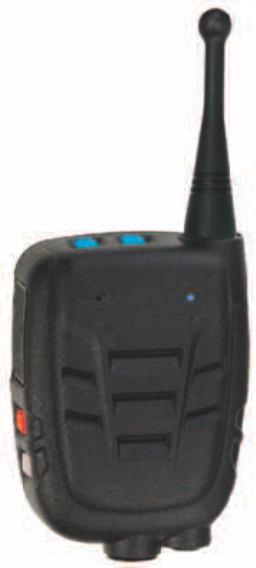
User
manual
Wireless Speaker Microphone

2
This product is designed to radiate low
levels of radio energy in accordance with
global government approved regula-
tory standards. It features Adaptive Power
Output. APO automatically adjusts the RF
power output in accordance with signal
required. This features limits and reduces
extraneous radiated radio energy. This also
helps minimize battery consumption and
extends battery shift life. Do not touch the
antenna when operational. Keep it 1.5 cm
(5/8 inch) or more away from your body to
ensure exposure levels remain at or below
the maximum levels.
Table of Contents
Parts & Functions ��������������������������������������������������� 4
Carry Clip Removal����������������������������������������������� 5
Operation Description ������������������������������������������ 6
Basic Operation ���������������������������������������������������� 8
•Power On & Off................................................ 8
•Volume Control ................................................ 8
•Transmitting/Receiving ....................................8
•Emergency (optional) ..................................... 8
•Multiple unit operation .................................... 9
•Motorcycle operation ..................................... 9
•Headset - Covert operation ........................... 9
Technical Notes��������������������������������������������������� 10
•Battery Charging ........................................... 10
•Replacing the battery pack ........................ 11
•Re-connection ............................................... 12
•Microphone adjustment ............................... 12
•Antenna choice & replacement ................. 13
•Installation & Connections ........................... 14
•Alternate congurations ............................... 16
•Approvals, Warranty & Warnings ................. 18
•Important safety and handling .................... 20
•Specications ................................................. 23
3
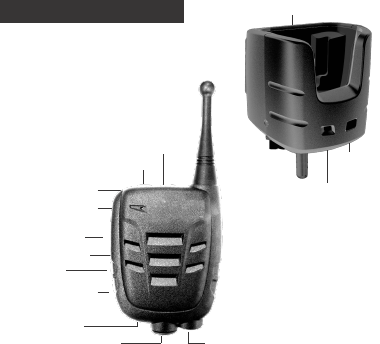
Antenna
Manual Off/On
Emergency
PTT: Press-To-Talk
Volume up
Volume down
Headset connector (Optional) Earpiece jack
DC charging
Microphone
Loudspeaker
Parts and functions
Volume up: adjusts speaker audio louder.
Volume down: adjust speaker audio softer - minimum setting.
Microphone: talk in a normal strength voice about 3 to 5cm (2”).
PTT: press to talk - beeps if pressed when out of range
Emergency: triggers host radio’s emergency function. Hold down
as per mobile radio’s emergency button operating instructions -
The unit will beep if pressed when out of range.
Manual off/on: hold for about 3 seconds to turn on or off. The spk
mic will sound escalating or de-escalating tone to advise status.
*Normal conguration see Installation section for alternatives. **Buy separately as needed.
Status light
(optional)
Status light
Manual
Off/On
Charging contacts
4
Connector
SMA
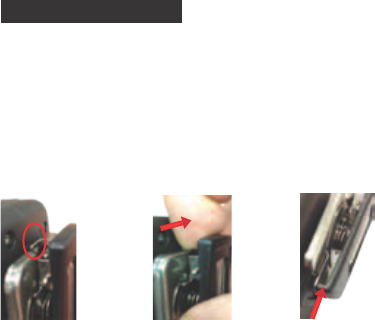
Carry Clip Removal
Standard spring belt clip
This is the traditional type most users are familiar with. It allows the
Spk Mic to be clipped to work vests, clothing, epaulettes, etc.
For maximum performance 360º around your vehicle it is recom-
mended that it be worn in a location that allows the antenna
to protrude above you body. The antenna should always be lo-
cated os that
To remove follow these three photos: Locate the metal securing
tag - Press the tag away from the Spk Mic whilst sliding the clip
upwards.
Identify
release
tag
Push out
while
sliding
clip up
5
DC charging: place into charger to automatically re-charge.
Headset connector: use with associated** headsets/accessories.
Earpiece jack: allows private listening via 3.5mm mono earpiec-
es.** The loudspeaker is disabled when 3.5mm plug is inserted.
Loudspeaker: Delivers loudspeaker audio - Automatically turns
off when inserted into mobile/base charger.*
Status light: glows blue when connected and operational. It will
ash when “out of range” or when the mobile charger unit is off.
from your Wireless Speaker Microphone supplier.
SMA Connector : Vital for maximum range. Unscrews at connector
to allow replacement if damaged. Use only original replacement

Operation Description
Congratulations on choosing the revolutionary Wireless
Speaker Microphone. This incredibly compact, light-
weight personal accessory extends the power of the
mobile radio to the palm of your hand, whether in and
out of the vehicle. It stands ready to re-dene mobile
network design by increasing user functionality and
mobility whilst dramatically improving the effectiveness
of your infrastructure investment. This visionary solution
provides users out of vehicle communications with the
power and performance of their mobile radio.
It cuts the cord and for the rst time puts the micro-
phone and radio system access into the palm of the
users hand when away from the vehicle, delivering true
mobility without system compromise. Users can feel to-
tally condent their private communications are kept
securedue to the smart 64 bit/128 bit encryption (model
dependent) functionality.
The Wireless Speaker Microphone uniquely incorporates
“hard wire coding” connection protocol that eliminates
any possibility of outside intrusion between the unit and
your vehicle’s mobile.
It unleashes the power of your mobile radio allowing
wireless communication with a xed mounted or vehi-
cle radio: 60, 150, 300 metres or more*. Now users can
communicate with enhanced clear audio, with the
power and range of their mobile radio, while not being
tied to the vehicle allowing the user to be truly mobile in
every operational environment.
Finally, if you go out of range, the blue LED will ash and
the unit will sound a warning tone if you press the PTT or
optional Emergency button, so you will know to move
back into your communication zone or, to be simply
aware. This ability to now communicate whilst outside
your vehicle is a great assistance to enhancing a safer
and more secure work environment for everyone who
carries a Wireless Speaker Microphone.
6
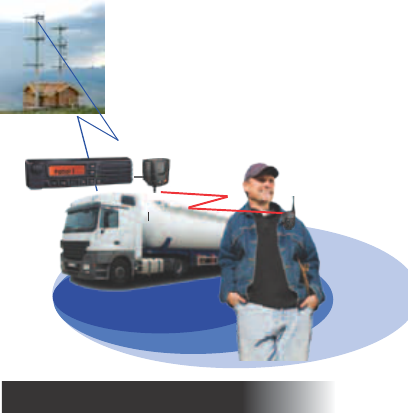
60m.... 150m.... 300m...
*Range is always dependent on the local terrain and
communications environment. A variety of antenna
congurations are available to enhance in-building
penetration or, simply to extend the overall communi-
cation zone around your vehicle. Ask your dealer which
antenna best suits your specic application.
How it works
Existing radio system
Mobile base/charger connects
to your mobile radio in your
vehicle (or ofce) - It passes all
voice trafc and alert tones to
and from your Wireless Speaker
Microphone
Communication zone
7

Basic Operation
Power On & Off
Usually the unit will be installed such that it powers off & on in syn-
chronization with the host mobile radio or by a manual switch t-
ted by your installation mechanic. You can manually turn off the
mobile charger by pressing the front orange button for 3 seconds
and the blue LED will extinguish. You can do the same on the
Wireless Speaker Microphone by pressing the lower grey button.
The speaker mic will sound a de-escalating tone. To power On,
do the same, releasing the button once the LED lights. The speak-
er mic will sound an escalating tone. The blue LED on both units
will ash momentarily and then go solid once they’re connected.
Volume Control
When you rst activate the unit you should rst ensure your mobile
radio’s volume is set to a comfortable listening level. You may
then adjust the Wireless Speaker Microphone volume by pressing
the right top button to increase or the left to decrease. There are
5 listening levels. The minimum level is not zero but is designed so
you can still quietly hear radio trafc.
Transmitting/Receiving
Use like any two way radio i.e. press the large grey PTT button to
talk and release to listen. Speak with a normal voice about 3-5cm
(2”) from the microphone port. Note: if you walk out of range the
blue status LED will ash. If you then push the PTT an alert tone will
sound to let you know your call is not getting though. Depending
on your location, you may nd you need to walk back about 10
meters (yards) to re-connect. Blue status light will glow solid. The
unit features a 3.5mm earpiece jack allowing use of a huge vari-
ety of personalized earpieces. Plugging in an earpiece disables
the internal loudspeaker for added privacy.
Emergency
If enabled, the emergency button can be used to trigger and
reset the emergency function in your suitably equipped mobile
radio. The time you hold the button is the time your mobile radio
sees the emergency command. So if your mobile radio requires
you to hold the radios front panel emergency button for 2 sec-
onds, then you should hold the Wireless Speaker Microphone
emergency button for 2 seconds.
8

Multiple Unit Operation
Up to three Wireless Speaker Microphones may be connected to
one radio device by use of the optional Interface box accessory.
Operation is identical to single user operation with the added
benet that, each party also hears each other talk when they
transmit. This functionality is ideal for police: where two ofcers
are assigned to a patrol van, or ambulance: where up to 3 para-
medics can communicate at a scene as well as with their control
room. It is also ideal for ofce use allowing up to 3 personnel to
access a local base or control station or remote control console
while moving around a building, shop or warehouse.
Note: communication between users is always routed back
through their respective chargers and not direct between units.
Ask your dealer for more information on this unique and valu-
able capability.
Motorcycle Operation
The Wireless Speaker Microphone is especially suitable for motor-
cycle use. Models tted with a 6 pin Hirose industrial connector
allow easy connection to a helmet microphone and dual ear-
piece t out. Making use of the handlebar PTT input, a bike can
be congured so that, when the rider is on the bike and presses
the handle bar PTT, their headset microphone audio is sent out
over the radio. Off the bike but still wearing the helmet, they can
press the Wireless Speaker Microphone PTT to talk, or nally, if they
remove their helmet, they can unplug the Hirose connector and
use the speaker microphone like standard.
Headset or Covert Operation
The 6 pin Hirose industrial connector also allows use of a variety
of heavy duty and lightweight headsets and application specic
audio accessories to enhance you communications capabil-
ity. Use either the headset/accessory’s integral PTT or use the
speaker mic PTT to transmit. The internal speaker is immediately
disabled when a headset is plugged in.
The small size of the unit may allow for its selective use in covert
applications. The remote monitor PTT function means someone
else can enable “listening” without the covert operative having
to touch anything. As audio is duplex (bidirectional) you can also
talk to them at the same time. A 128 bit version is also available
to ensure high levels of voice security.
9
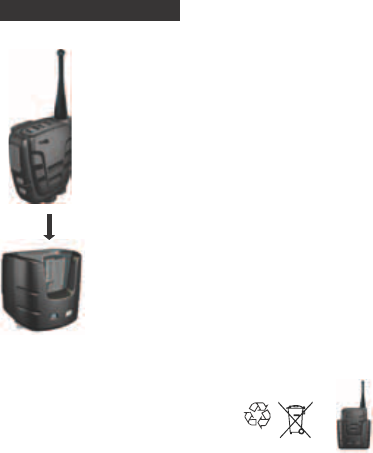
Technical Notes
10
Battery - Charging
The Wireless Speaker Microphone should
be charged overnight before initial use.
Thereafter it may be left in the charger
unit between calls, or may be worn all
day and placed back at the end of the
work day. The unit is designed to provide
about 10-12 hours operation between
charges. If the unit does start to go at a
short beep will sound about once every
2 minutes. You should then re-charge the
unit as soon as practicable, A fully dis-
charged battery will typically recharge
in less than 5 hours or less if only partially
discharged. The battery will re-charge
even if the mobile charger unit has been
turned off. The microphone’s blue status
light will indicate charging mode.
Li-POL
Please recycle thoughtfully
Simply place into pocket.
NB: do not allow debris to ll the pocket
and prevent the microphone from
making contact with the charging pins.

Replacing the battery pack
Like all re-chargeable products, periodic replacement
of the internal battery is required. The Wireless Speaker
Microphone features a 1200mA Lithium Polymer battery
to provide typically 10-12 hours operation when used
with a busy radio channel.
To maximize the life of a Lithium battery its is better to
keep it topped up by returning it to the charger often
rather than waiting for it to rst go at - which was the
case with older nickel based batteries. Typically you
can expect to get about 400-500 full re-charge cycles
before the battery will require replacement.
When you notice the sounding a small chirp, it in-
dicates the battery is nearly at and should be re-
charged. When you notice this occurring far more often
than usual, it may mean it is time for the battery to be
replaced. the process is simple and should only take
your radio service supplier about 5 minutes to replace
and test. Replacement of the battery should be ONLY
undertaken by a qualied service technician so as to
ensure no damage occurs to internal circuitry and to
ensure the housing’s weatherproof integrity is not com-
promised.
The replacement battery part number is:
XSMB-C12: 1200mA Lithium Polymer battery pack
After replacement, the Wireless Speaker Microphone
must be rst placed back into the mobile charger and
will initially need to be charged for 12 hours prior to
commencement of use. Depending on the situation
it may also need to be “re-connected” to the mobile
charging unit)
11
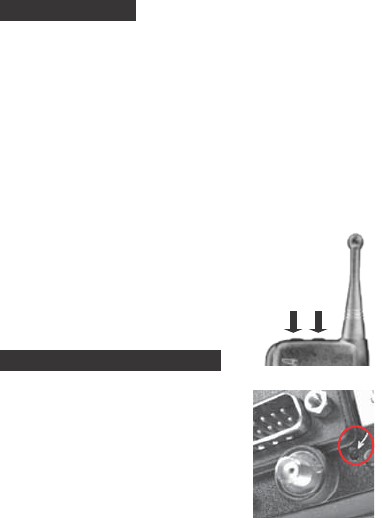
Re-connection
Each Wireless Speaker Microphone is uniquely con-
nected to a specic mobile charger. This ensures that
all communications between the two units are secure
and cannot be compromised or interfered with by a
third party. In the event of a Wireless Speaker Micro-
phone being lost, it can be permanently disconnected
from the mobile charger by connecting with a new re-
placement unit.
How to re-connect: hold the speaker mic while pressing
both the blue up and down volume controls until the
blue LED ashes and the speaker mic beeps.(About 8 secs.)
Press together
until LED ashes
and unit beeps
Now place the speaker mic back
into the mobile charger. After a few
seconds the speaker mic will sound
a conrmation two tone and the
blue LED on both units will glow solid
to indicate connection is complete.
Microphone adjustment
The Wireless Speaker Microphone
system is usually factory set for stand-
ard audio levels required to provide
satisfactory mobile radio transmit
voice levels. Should the volume be
too soft or loud and distorted, it may
require re-adjustment to set the cor-
rect level for your installation.
Using a radio systems analyser to monitor the radio
channel adjust the internal trim pot so as to achieve
maximum permitted voice deviation within minimum
voice clipping (distortion). See photo for access point
Qualied service personnel only!
12

Antenna choice & replacement
The XRMA multipolarity antenna provides enhanced
coverage when mounted on an unobstructed area of
a vehicle’s roof and should be connected via the sup-
plied low loss coax cable to the output of the mobile
charger. Alternatively use of an approved bidirectional
amplier (BDA) may also be installed to further enhance
in-building coverage from your vehicle. The XBDA is in-
stalled in series by using a 3 metre (10’) length of RG58A
connected to the output of the mobile charger. The
XRMA antenna then connects to the output of the
XBDA. Only qualied radio service personnel should in-
stall a BDA so as to ensure the effective radiation level
remain in full compliance with regulatory requirements
in your country of operation�
In the event of a damaged or lost antenna, only original
replacements should be used so at to not compromise
the units type approval certication.
The antenna on the speaker microphone is a unity gain
ground independent antenna to ensure the maximum
multi-directional range. The mobile charger output pro-
vides a reverse polarity sma female antenna connec-
tor as does the XBDA.
The following accessories are available from your Wireless
Speaker Microphone supplier:
XSMA - replacement speaker mic antenna
XRMA - Unity gain, bracket mount, multi-polarity an-
tenna with 5 metre (17’) low loss LMR200 coax and
untted RP SMA male connector.
XBDA - 12dB gain bidirectional amplier with 3 metre
(10’) RG58A coax tail and 1 metre (39”) DC power
cable.
13
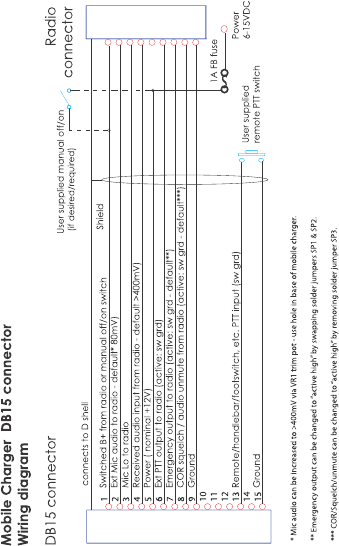
14

1� Switched B+: Used to automatically turn on/off Wire-
less Speaker Microphone if connected to host radio
switched B+ output, if not, the user should supply man-
ual on/off switch. Note: internal speaker microphone
battery will still charge when the unit is turned off.
2� External Mic Audio: Audio from the Wireless Micro-
phone that is to be transmitted over the host mobile
radios transmitter. It is factory set for 80mV RMS.
3� Radio Mic Lo: This is microphone audio ground.
4� Receive Audio: Receive audio from the host mobile
radio that you wish to be sent to the Wireless Micro-
phone. Ideally it should be sourced pre-volume con-
trol but can be post as long as the host mobile radio’s
speaker audio has been sent for comfortable listening
in the vehicle.
5� Power: connected via a 1 amp in-line fuse preferably
direct to a vehicle’s 12V battery but can be any volt-
age from about 6-15VDC. The current consumption is
typically 60mA with peak current of 420mA.
6� Ext� PTT: Switched ground output designed to cause
the host mobile radio to transmit.
7� Emergency: Output intended to connect to the host
mobile radio’s emergency input. It is normally provides
an active switched ground but can be jumpered to be
active open circuit/high. The time held low (or high) is
the exact time that the user presses their Emergency
button. This output could be used for other functions
such as to trigger the panic function of a car alarm
system, providing it is correctly “buffered” so as to not
cause damage to the mobile charger.
8� COR/squelch/audio unmute: Input designed to moni-
tor the receive status of the host mobile radio. Ideally,
it is driven by an “audio unmute” command in the host
mobile. i.e. when the radio’s speaker unmutes to pass
audio then the COR input should toggle in sync.
Installation & Connections
15

Alternatively, it could be driven by the radio’s unsquelch
command that factors in reception of required correct
CTCSS tones, etc. Internal jumpering caters for active
low or high inputs.
9� Ground: DC ground connection.
13� Remote PTT: This provides a remote alternative to
transmit Wireless Speaker Microphone audio via the
host mobile radio. You may choose to connect to a
motorbike handle bar PTT, a hidden palm or footswitch,
a wireless PTT device, or even to an output from the host
mobile equipped to provide remote radio monitoring of
the Wireless Speaker Microphones users audio. In such
remote monitoring cases, use of the remote PTT input
causes the sensitivity of the Wireless Speaker Micro-
phone to be greatly increased, so a control room oper-
ator can more easily monitor the health or safety of the
user. There is no increased audio gain when a headset
is connected to the base of the Wireless Microphone.
15� Ground: Additional DC ground connection.
Alternate Congurations
Some alternate congurations are available by in-
ternal jumpering of the mobile charger unit. These
are provided to typically allow compatibility with
different mobile radio types.
Re-conguration of these jumpers should only be
undertaken by qualied radio service personnel.
To access, rst remove the rear mounting plate. Next
remove the 4 screws to access internal PCB. Take ex-
treme care when handling the PCB to prevent damage
by electrostatic discharge (ESD) or to internal wiring.
Re-assemble carefully remembering to re-insert the belt
clip securing spring.
16
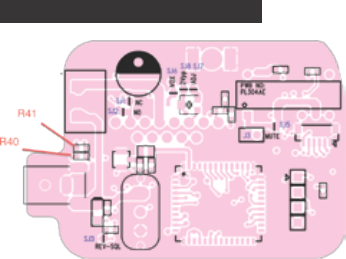
17
Install Jumper conguration:
SJ1 Default Out -Fit for for N/C emergency trigger
SJ2 Default In -Remove for N/C emergency trigger
SJ3 Default In -Remove for active Hi radio COR
SJ4 -Future use
SJ5 Default In -Remove for special applications
SJ6 Default In -Remove for Vox disable
SJ7 Default Out -Fit for adjustable Rx audio in
SJ8 Default In -Remove for adjustable Rx audio in
R40 Default not tted -Fit 0 ohm* for DC shift COR detect
R41 Default tted -Remove for DC shift COR detect
* or as appropriate
J3 default In -Remove to prevent the wireless mic
turning off when placed inside the mobile charger. This option is
generally recommended only when the host radio has no inter-
nal or external speaker. Removing J3, may cause the re-charge
time to increase signicantly on a very busy radio channel.
Mobile Charger PCB layout

RADIO AND TELEVISION INTERFERENCE
The equipment described in this manual generates, uses, and radiates radio-
frequency energy. If it is not installed and used correctly—it may cause inter-
ference with radio and television reception.
CE DECLARATION
This equipment has been tested and found to comply with the following har-
monised European Norms:
•EN300328 (radio and telecommunications terminal equipment)
•EN55024 (electromagnetic immunity) •EN55022 Class B (electromagnetic
emissions) •EN 60950 (electrical safety) •EN301489 (electromagnetic compat-
ibility and radio spectrum matters) Based on the results of these tests, Wireless
Corporation declares that the above mentioned devices conform to Article
10.1 of the European Council Directive 89/336/EEC, and their amendment
Directive 93/68/EEC, and to the Directive 1999/5/EC and indicates this con-
formity by the CE-sign on each device. The device must be installed and oper-
ated in strict accordance with the instructions given in this user manual. Any
changes or modications to this product that were not specically authorised
will invalidate this declaration.
FCC NOTICE
This equipment complies with Part 15 of the FCC Rules. Operation is subject to
the following two conditions: (1) this device may not cause harmful interfer-
ence, and (2) this device must accept any interference received, including
interference that may cause undesired operation.
This equipment has been tested and found to comply with the limits for a Class
B digital device, pursuant to Part 15 of FCC Rules. These limits are designed to
provide reasonable protection against harmful interference in a residential
installation. This equipment generates, uses and can radiate radio frequency
energy and, if not installed and used in accordance with the instructions, may
cause harmful interference to radio communications. However, there is no
guarantee that interference will not occur in a particular installation.
You can determine whether the equipment is causing interference by dis-
connecting power. If the interference stops, it was probably caused by the
equipment. If the equipment does cause interference to radio or television
reception, you may be able to correct the interference by using one or more
of the following measures:
•Rotate the television or radio’s antenna until the interference stops.
•Move the Wireless Microphone further away from the television or radio.
If necessary, consult your two way radio dealer or an experienced radio/
television technician for help. Changes or modications to this product not
authorized by the manufacturer could void the FCC Certication and negate
your authority to operate the product.
Notice : Changes or modications not expressly approved by the party for
compliance could void the user’s authority to operate the equipment.
IMPORTANT NOTE:
To comply with the FCC RF exposure compliance requirements, no change
to the antenna or the device is permitted. Any change to the antenna or the
device could result in the device exceeding the RF exposure requirements
and void user’s authority to operate the device.
Type Acceptance
18

The manufacturer warrants each new product sold to be free from defects
in material and workmanship under normal use and service. The obligation
and liability under this warranty is limited to the repair or replacement at its
factory, at the option of the manufacturer, of any such product which proves
defective within the quoted warranty period, twelve (12) months for the prod-
ucts after delivery, and is found to be defective in material and workmanship
by inspection. Products of warranty consideration shall be returned with all
transportation charges prepaid to the manufacturer, or our nominated local
service supplier in shipping containers which are adequate to prevent loss
or damage in shipment. The manufacturer, will pay the return carriage costs
for the products. Products repaired or replaced under this warranty are war-
ranted for the unexpired portion of the original warranty. This warranty is invalid
if the factory-applied serial number, date code label, or product label has
been altered or removed from this product. The manufacturer shall not be
obligated or liable under the warranty for apparent defects which examina-
tion discloses are due to tampering, misuse, neglect, improper storage, acts
of nature, physical abuse, normal wear and all cases where the products are
disassembled by other than authorised service representatives. In addition,
the manufacturer shall not be obligated or liable under this warranty unless
the date of delivery to the rst end user shall be within one (1) month from the
date of delivery to the original purchaser, if different from the rst end user, and
further provided that written notice of any defect shall be given to the manu-
facturer within thirty (30) days from the date such defect is rst discovered. In
no event will the manufacturer accept consequential damages for products
supplied and are then found to have become defective.
Headsets and earpieces used with this product are capable of delivering
sounds at loud volumes. Exposure to such sounds can result in permanent
hearing loss damage. The volume level may vary based on conditions such
as host radios volume settings and the environment. Please read the following
safety guidelines below prior to using a headset or earpiece:
1. Prior to using this product follow these steps:
•Before putting on the headset, turn the volume control to its lowest level,
•Put the headset on, and then slowly adjust the volume control to a com-
fortable level.
2. During the use of this product:
•Keep the volume at the lowest level possible and avoid using the headset
in noisy environments where you may be inclined to turn up the volume;
•If increased volume is necessary, adjust the volume control slowly.
•If you experience discomfort or ringing in your ears, immediately discon-
tinue using the headset and consult a physician.
With continued use at high volume, your ears may become accustomed
to the sound level, which may result in permanent damage to your hearing
without any noticeable discomfort. Using a headset while operating a motor
vehicle, motorcycle, watercraft may be dangerous, and is illegal in some juris-
dictions. Check your local regulations and laws.
Warranty
Headset use warning
19

To avoid injury, read all operating instructions and the following safety informa-
tion before using the Wireless Speaker Microphone.
Exposure to Radio Frequency Energy:
The unit transmits and receives radio frequency (RF) energy through its an-
tennas. The antennas are located at the top edge of the unit. The Wireless
Speaker Microphone is designed and manufactured to comply with the limits
for exposure to RF energy set by international regulatory agencies, including
the FCC of the United States, IC of Canada, MIC of Japan, and the Counsel of
the European Union, among others. The unit has been tested and meets the
FCC, IC, and European Union RF exposure guidelines for 802.15 operation. To
ensure exposure levels remain at or below the maximum safe levels, when car-
rying the unit ONLY use the Wireless Speaker Microphone with the manufac-
turer’s supplied clothing clip or a non-metalic holder that ensures the antenna
remains greater than 10mm (2/5 inch) from your body at all times. An external
antenna is connected to the output connector on the mobile charger or to
the output connector on the XBDA bidirectional amplier. Always keep your
body at least 20cm (8”) from the antenna whip. The XBDA is only approved
for use with this mobile charger unit in accordance with FCC regulations� refer
FCC ID: I7OBT-24D�
Potentially Explosive Atmospheres:
Turn off the unit when in any area with a potentially explosive atmosphere.
Do not charge, and obey all signs and instructions. Sparks in such areas could
cause an explosion or re, resulting in serious injury or even death.
Areas with a potentially explosive atmosphere are often, but not always,
marked clearly. Potential areas may include: fueling areas (such as gas sta-
tions); below deck on boats; fuel or chemical transfer or storage facilities;
vehicles using liqueed petroleum gas (such as propane or butane); areas
where the air contains chemicals or particles (such as grain, dust, or metal
powders); and any other area where you would normally be advised to turn
off your vehicle engine.
Radio Frequency Interference:
Radio frequency emissions from electronic equipment can negatively affect
the operation of other electronic equipment, causing them to malfunction.
Although the Wireless Speaker Microphone is designed, tested, and manufac-
tured to comply with regulations governing radio frequency emission in coun-
tries such as the United States, Canada, the European Union, and Japan, the
wireless transmitters and electrical circuits in the unit may cause interference in
other electronic equipment. Therefore, please take the following precautions:
Important Safety and Handling Information
20
WARNING: Failure to follow these safety instructions could result in
re, electric shock, or other injury or damage to the unit or other
property. Read all safety instructions for any products and acces-
sories before using with the unit. The Manufacturer is not responsible
for the operation of, or any damage caused by, third-party acces-
sories or their compliance with safety and regulatory standards.
i/Aircraft: Use of the Wireless Speaker Microphone may be prohibited while
traveling in aircraft.
ii/Vehicles: Radio frequency emissions from the unit may affect electronic
systems in motor vehicles. Check with the manufacturer or its representative
regarding your vehicle.
iii/Pacemakers: The Health Industry Manufacturers Association recommends
that a minimum separation of 15 cm (6 inches) be maintained between a
handheld wireless phone and a pacemaker to avoid potential interference
with the pacemaker. Persons with pacemakers:
a/ Should always keep the Wireless Speaker Microphone more than 15 cm
(6 inches) from the pacemaker when turned on
b/ Should not carry it in a breast pocket
c/ Should use the ear opposite the pacemaker to minimize the potential
for interference If you have any reason to suspect that interference is tak-
ing place, turn it off immediately.
iv/ Hearing Aids: The Wireless Speaker Microphone may interfere with some
hearing aids. If you experience interference, consult the hearing aid manu-
facturer or your physician for alternatives or remedies.
v/ Other Medical Devices: If you use any other personal medical device, con-
sult the device manufacturer or your physician to determine if it is adequately
shielded from radio frequency emissions from the unit.
vi/Health Care Facilities Hospitals and health care facilities may use equip-
ment that is particularly sensitive to external radio frequency emissions. Turn
the unit off when staff or posted signs instruct you to do so.
vii/Blasting Areas and Posted Facilities To avoid interfering with blasting opera-
tions, turn off the Wireless Speaker Microphone when in a “blasting area” or in
areas posted “Turn off two-way radio.” Obey all signs and instructions.
Repairing or Modications:
Never attempt to repair or modifythe Wireless Speaker Microphone yourself.
The unit does not contain any user-serviceable parts, except (where applica-
ble). Disassembling, including the removal of external screws and back cover,
may cause damage that is not covered under the warranty. If the unit has
been submerged in water, punctured, or subjected to a severe fall, do not
use it until you take it to an Authorized Service Provider. Service should only be
provided by the Manufacturer or an Authorized Service Provider. If you have
questions or for service information, contact the Manufacturer or an Author-
ized Service Provider.
Battery Replacement:
Do not attempt to replace the rechargeable battery in the unit yourself. The
battery should be replaced only by the Manufacturer or the Authorized Ser-
vice Provider.
Charging:
To charge the unit, use only the mobile or desktop charger. When using the
desktop charger, make sure the plug pack is connected before you plug it
into a power outlet. Do not connect or disconnect the AC/DC plug pack with
wet hands. 21
The AC/DC plug pack may become warm during normal use. Always allow
adequate ventilation around the AC/DC plug pack and use care when han-
dling. Unplug the AC/DC plug pack if any of the following conditions exist:
1/ The power cord or plug has become frayed or damaged.
2/ The adapter is exposed to rain, liquid, or excessive moisture.
3/ The adapter case has become damaged.
4/ You suspect the adapter needs service or repair.
5/ You want to clean the adapter.
Road Safely:
Use while driving a vehicle or riding a motorbike may be distracting. If you
nd using the Wireless Speaker Microphone disruptive or distracting while driv-
ing or riding, pull off the road and park before making or answering a call.
Use of the Wireless Speaker Microphone alone or with headphones (even if
used only in one ear) while driving or riding is not recommended and is illegal
in some countries. Consider using a compatible hands-free device. Use of a
hands-free device may be required in some areas. Check and obey the laws
and regulations regarding the use of mobile devices like the Wireless Speaker
Microphone in the areas where you drive or ride.
Vehicles Equipped with Air Bags:
An air bag inates with great force. Do not store the Wireless Speaker Micro-
phone or any of its accessories in the area over the air bag or in the air bag
deployment area.
Carrying and handling:
The unit contains sensitive components. Do not drop, disassemble, micro-
wave, burn, paint, or insert foreign objects. Do not use the unit if it has been
damaged—for example, if it is cracked, punctured, or damaged by water.
Keeping Clean:
Clean the Wireless Speaker Microphone and mobile charger immediately
should they come into contact with any contaminants that may cause mal-
function—e.g, ink, oils, dirt, food and drinks. To clean, turn off (press and hold
the On/Off button) and remove all cables. Then use a slightly damp soft cloth.
Don’t use solvents, turpentine window cleaners, or abrasive household clean-
ers to clean the unit.
Connectors and Press buttons:
Never force a connector into a port or apply excessive pressure to a button,
because this may cause damage that is not covered under the warranty. If
the connector and port don’t join with reasonable ease, they probably don’t
match. Check for obstructions and make sure that the connector matches
the port and that you have positioned the connector correctly in relation to
the port.
22

Accessories Performance:
Not all Hirose 6 pin accessories are fully compatible withthe unit.
Under some conditions, certain accessories may affect the wireless perfor-
mance. Reorienting or relocating the Wireless Speaker Microphone and the
connected accessory may improve wireless performance.
Acceptable Temperatures:
The unit is designed to be operated in temperatures normally between -10º
and 45ºC (14º to 113ºF) and stored in temperatures between -20º and 50ºC (-4º
to 122ºF). Lower or higher temperature conditions might temporarily shorten
battery life or cause the unit to temporarily stop working properly. Leaving
the Wireless Speaker Microphone in a parked vehicle in direct sunlight might
cause it to exceed these storage or operating temperature ranges. Avoid dra-
matic changes in temperature or humidity when using it as condensation may
form on or within the unit. When you’re using the Wireless Speaker Microphone
or charging the battery, it is normal for it to get warm.
23
Subject to change or improvement without notice
The equipment has been designed to meet the following global
specications:
Dimensions: 88x28x63mm (spk mic) 80x80x60 (chgr)
3.46x1.1x2.48” (spk mic) 3.15x3.15x2.36”(chgr)
Weight: 149 grams (spk mic) 125 grams (chgr)
Frequency: 2.40-2.48GHz FH Spread Spectrum
Protocol: 802.15 based
RF Power: <100mW
RF Connectors: RP SMA Female
Rated audio/distortion: >250mW @ 6% THD
Operating Voltage: 3.7VDC
Operating Temperature: -10ºC to+45ºC (extreme -20ºC to +50ºC)
14ºF to+113ºF (extreme -4ºC to +122ºF)
Shock & Vibration: Mil Std 810 C/D/E/F
Humidity/Rain/Dust: IEC529, IP55 (spk mic only)
Type acceptance: CE, FCC,
FCC ID: I7OBT-24H / I7OBT-24D
0681
Specications
All rights reserved ©2012
All logos are trademarks or registered trademarks of their respective
owners.